
credit |
In full tribal gear, especially for the
portrait,
circa 1850. Shown in this picture with a British Officer's epaulets
signifying his alliance against the Americans during the war of
1812. This portrait hangs in the Michigan Historical Museum in
Lansing. It has been suggested that this painting was done by the
acclaimed artist John Mix Stanley.
|
|
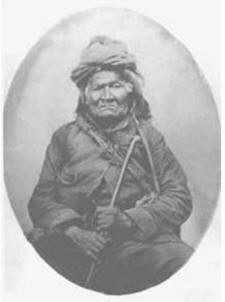
credit |
This is a "ambrotype" (similar to a "tintype")
photograph of Chief Okemos. He sat for this image a year before he
passed. It seems that this piece disappeared for a while and then
resurfaced around 2005 on eBay. The Michigan Historical
lists it as being in their archives. It is known that this image was
donated to the
Pioneer Society of the State of Michigan (which became the
Michigan Historical Society) by A. O. Jenison. It is unclear as to
if there are actually multiple copies, since it is unlikely that
was ever left the hands of the State of Michigan's Archives.
Read More... |
|

credit |
It appears that this photo was taken during the same sitting as
the 'Lost Tintype' above. It is unclear as to what process was
used to produce this image. It could be a reproduction from an
original negative. The similarities in the two subjects, suggest a
merely different pose. This print displays much more detail and
sharpness. For example, notice the background that appears in this
image versus the image above. |
|
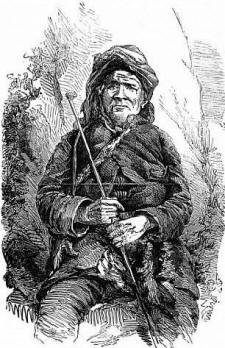 |
This image appeared in the March 5th, 1859 edition of The
London Illustrated News (which was the world's first illustrated
weekly newspaper; It was published from 1842 until 2003). The
image was included with a memorial article about Chief Okemos.
Because there was no ability to mass print a photo, this rendering
is a hand etched image that was suitble for printing. It is based
upon the tin-type (or ambrotype)
above.
Read More... |
|
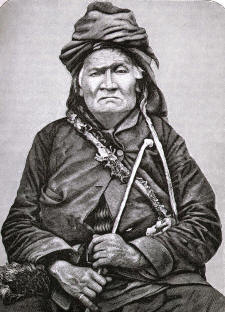
zoom |
This too is actually an etching, based directly upon the tin-type
above. If you zoom into the full size file, you will see the
masterful work it takes. Do not have a source for this particular
piece. |
|
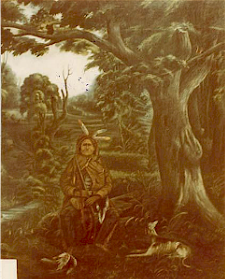
zoom
credit |
This oil painting's artist is unknown and is
simply titled "Chief Okemos". The Smithsonian's summary describes the setting as "An Indian chief is
seated in a forest and holding a rifle. A dog sits beside him." If
you look closely, you can see what appears to be a bird on the
left. A successful hunt perhaps. In this image it appears that Chief
Okemos has both a turban and feathers for a headdress. The date painted is listed as 1850.
It's current location is at the Clark Historical Museum, Central Michigan University,
Mt. Pleasant Michigan; it is not know if it is on display to the
public.
|
|
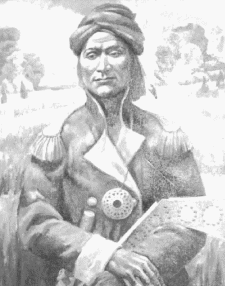 |
John DeMartelly, a noted artist and Michigan State
University Professor, was commissioned by Capitol Federal Savings &
Loan in 1976, to deliver this rendering. Believed to be a watercolor
portrait, this piece is simply titled "Chief Okemos".
Because the record only holds images of Okemos as an older man, the
artist endeavored to represent the Chief earlier on his "path". The
notes and proclamation were discovered by this author in the
course of research.
Artist's handwritten notes
Resolution By Michigan
House of Representatives
|
|
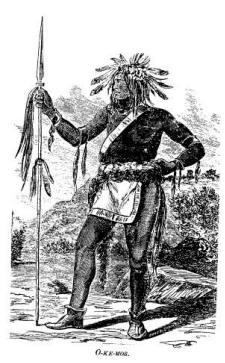
credit |
This sketch is taken from the historical
fiction novel by F. J. Littlejohn, "LEGENDS OF MICHIGAN AND THE OLD
NORTH WEST" published in 1875. This is a collection of short
adventure stories where Chief Okemos is a subject along with other
historical
American Indian figures and circumstances. Like the story in which
it is contained, the sketch is also fictional. Little, if anything,
resembles features that we associate about Chief Okemos.
Read
from
LEGENDS OF MICHIGAN AND THE OLD NORTH WEST... |
|
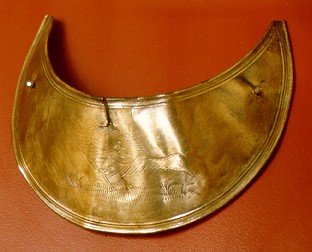
credit |
The exhibit "First Peoples" at the Michigan
Historical Museum (Lansing) displays this gorget, a neck ornament, that belonged to Chief Okemos in the 18th century.
|
|
|
|
|
|

